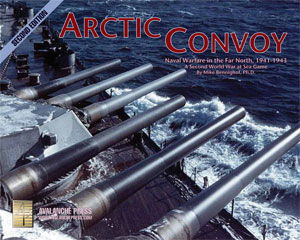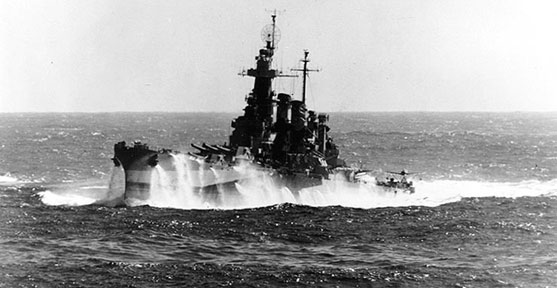| Overrated
The
New American Battleships of World War Two
By David Hughes
December 2018
 I have a confession to make. I really like
both of the Avalanche naval systems and have
played almost all of their games, but I find the relative values of those enormously powerful modern
U.S. battleships, to put it politely, suspect. I have a confession to make. I really like
both of the Avalanche naval systems and have
played almost all of their games, but I find the relative values of those enormously powerful modern
U.S. battleships, to put it politely, suspect.
As far as guns are concerned, the North
Carolina and her siblings have gun
factors of 16-0-6, the overwhelming Iowa class
18-0-5. Now compare that with the feeble
Europeans: the King
George V 9-0-6, the Richelieu 10-3-0,
the Vittorio
Veneto 11-5-0 and the Bismarck 10-4-3.
It seems that the American ships are so different,
so much more powerful, that they should all
be defined as "super-battleships." After
all, the Queen
Elizabeth, the first "super-dreadnought," was
only a 10-3-0 compared with the 9-3-0 of Iron Duke, the
last British dreadnought. The Dreadnought herself is rated at 7-0-2, while a capable
pre-dreadnought like the Austro-Hungarian Radetzky is a 4-0-4. Note the implication:
American battleships compared with their
European contemporaries represent a leap
in capability greater than that of the first
dreadnought or super-dreadnought.
The same pattern shows in the armour. While
the King
George V, Vittoria Veneto and Richelieu class all have a value of 15, the North
Carolina group rate 18. Only the Bismarck is tougher
at 20, which must inevitably be trumped by Iowa at 21.
Of course this is all utterly implausible.
The Americans had previously built good but
unimaginative battleships, with their guns
emphasised over speed, but which bore a couple
of obvious design flaws such as cage masts
and inadequate fire-control systems. After
the Second World War they were not considered
to be more impressive than contemporary British
or French designs. A typical comment comparing Iowa and Vanguard was simply that the American
ship was "very pretty but a pig of a
sea-boat in heavy seas." This referred
to her long narrow bow, needed to achieve
a form capable of high speed, but lacking
buoyancy.
It was only much later, as all other battleships
were scrapped, that the Navy's claims about
these ships became transmuted into fact.
In effect the United States Navy trumpeted
two features of the new battleships as being
so innovative and impressive that the ships
outmatched all other warships. These were
heavy shells and inclined armor, yet in truth
both concepts already tried and discarded
in other navies.
The Main Guns
No doubt to the surprise of many, the American
battleships' 16-inch guns were neither a
new, nor the best American weapons available.
They had originally been developed for the
battleship classes cancelled by the Washington
Treaties and were competent but pedestrian
designs. A considerably more powerful, if
heavy, 16-inch gun, the m1919M2 had been
designed and built for the United States
Army, with examples installed in Oahu and
elsewhere. In retrospect the duplication
of effort involved seems as extreme as with
the Japanese Army and Navy. When the new
ships were being built in the 1930s the original
design was used with only two major modifications.
One was to re-design the breech to fit the
new turrets, the other to install a chrome
liner that would improve barrel life. At
the time the main selling point put forward
by the navy was that the gun would therefore
cost less to maintain than a comparable British
design.
The sole distinction was in their new, heavy
shells. To put this in perspective, the British
16-inch in Nelson fired a 2,048 pound shell,
the powerful American Army 16-inch gun a
2,340 pound while the Navy shell weighed
a massive 2,700 pounds. Now there is an undeniable
advantage to a heavy shell, since its greater
mass would achieve greater penetration, everything
else being equal. Also at the time American
naval experts were immersed, almost obsessed,
in calculating "immune zones," angular
penetration rates and other mathematical
exercises in which a high penetration value
was all that mattered. What was forgotten
in this academic exercise is that the seemingly
superior heavy shell had two very serious
relative weaknesses.
It could not go very far and, equally important,
it took a long time to get there. I have
no intention of deluging a Daily Content
reader with a mass of statistics, so have
simply picked a single comparison, taken
from a readily accessible source, “Naval
Weapons of World War Two” by John Campbell.
The British 16-inch gun (the variant found
in Nelson) could reach 39,780 yards, the
American 16/45 only 36,900. Even more important
was how long a shell took to reach its target.
Firing at 35,000 yards or more, the American
shell took about seven seconds longer to
reach the target. Now that may not seem a
long time when reading this article, but
it was when firing at a target moving at
30 miles an hour and frequently changing
direction to confuse the enemy spotters!

A pig of a sea boat. North
Carolina off the
Philippines, December 1944.
None of this is rocket science and it was
known to every gun designer on the planet.
However, elsewhere it was recognised that
what mattered most was to hit the target
as many times as possible, recognising that
the chance of hitting a ship, let alone the
tiny part of it that composed an armor belt
or deck, was already very low. They therefore
designed guns that generated the highest
possible range, lowest time of flight and
highest accuracy factor (the best example
being the magnificent Italian 381mm/50),
or installed as many gun barrels as possible.
The last approach was taken by the Royal
Navy, whose initial intent was to equip the King George
V class with twelve 14-inch guns.
Eventually this weakness was recognised by
the United States Navy who ordered the barrel
of their 16-inch guns extended by 5 calibres,
so increasing the flight-speed of the heavy
shell. Naturally a simple barrel extension
creates problems of its own.
Of course when the range was very short,
as happened to be the case in the only battle
ever fought by these ships, the heavy shell
proved its worth. Washington, in the fortunate
position of being able to fire without being
spotted at a range of 8,400 yards, pounded
the obsolete battle cruiser Kirishima (she
entered service in 1915) into a blazing hulk.
It was commonly believed that she only hit
seven times, but a new evaluation (for those
interested, in "Warship International
44/4") suggests that between 14 and
20 shells (of the 75 fired) hit the target.
If correct this is excellent and deadly shooting.
Certainly South
Dakota, crippled by the Japanese
ship and her consorts, owed her survival
to her consort and not to her armor. The
questionable and sometimes bizarre nature
of this armor system will be dealt with in
a subsequent Daily Content, after covering
the guns of the Iowa class.
Continued
in Part 2: Destroyer Killers.
The
guns of the Alabama can get a workout
at any range
in
Second
World War at Sea: Arctic Convoy. Order
for yourself!
|
